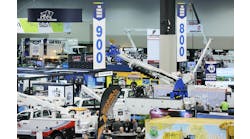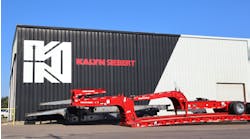Fleets operating certain specialized vocational vehicles or trailers can incur significant downtime and repair costs when air-springs are under inflated and bottom out, damaging the air-springs bellow.
Air-suspension systems face a constant risk of air-spring deformation known as “pinching.” This occurs when the entire weight of the truck or chassis is exerted on a depressurized air-spring, trapping the bellow between the air spring top plate and piston. The air-springs bellows is cut, disabling the vehicle. The bellow cannot be repaired, and air-spring replacement can be costly, totaling a minimum of $1,400 for material, labor, towing, and especially vehicle downtime. A known solution is to keep the air-springs pressurized so that such pinching does not occur.
In order to prevent air-springs from pinching, air suspension system needs to retain pressure within air-springs while vehicle is in operation like outriggers. One solution is to equip the air suspension controls with a height control valve (HCV) that can be commanded to “block” the discharge of air from the air springs under this condition, preventing air-spring bellows from pinching.
Overview
Fleets operating certain specialized vocational vehicles or trailers can incur significant downtime and repair costs when air-springs are under inflated and bottom out, damaging the air-springs bellow.
Air-suspension systems can face a risk of air-spring damage known as “pinching.” This occurs in applications if air-springs are depressurized and stretched into “hour-glass” shape. As the distance between the frame and axle(s) increases, the height control valve (HCV) tries to return the vehicle to normal ride height by discharging air from the air-springs, allowing the bellow to be pulled into an “hourglass” shape. So when the vehicle returns the axle and frame to its normal position, the air-spring bellows can become pinched between the top plate and piston, leading to permanent deformation and damages.
Such pinching damages the air-springs and requires replacement. Replacement can be costly, totaling a minimum of $1,400 for material, labor, towing, and vehicle downtime. In addition, air spring manufacturers will not warranty a unit destroyed by under-inflation; the entire repair cost is borne by the vehicle operator. A solution is to keep the air-springs pressurized when the vehicle is lifted from its outriggers so that pinching does not occur.
In order to prevent air-springs from depressurizing during this condition, the exhaust circuit of height control valve needs to be isolated. A solution to this can come from an air suspension system that is equipped with a valve that can perform blocking. The blocking function prevents release of air from air-springs.
An early solution to maintaining air pressure in the spring was to install additional components in the form of manual or electric bypass valves and pneumatic plumbing. This increased complexity and cost, and was more difficult to troubleshoot.
A more cost and space efficient solution has recently been developed—a valve that integrates ride height control during over-the–road operation and blocks air-spring discharge when activated. Such a system is dependent on just one valve to achieve the blocking function and control ride height.
Vocational vehicles typically present unique design challenges for engineers due to the severe conditions such vehicles are exposed to throughout their use. This class of vehicles has niche requirements and calls for custom solutions to solve those needs.
Blocking air for outriggers
In a boom truck, a truck with a multi-section boom crane (which usually is a commercial truck-mounted crane), one key pain point is damage to the air-springs. This is a very common occurrence resulting from the nature of the outrigger function. When the truck is lifted using the hydraulic outriggers, the axle and wheels are lifted above ground, which increases the distance between the axle and chassis. In this mode, the height control valve is in the exhaust position, which deflates the air-springs causing them to stretch to an “hour-glass” shape. When the work is done and the truck returns to normal operation, the entire vehicle weight rests on the empty now deflated air-springs, pinching the air-spring bellows and damaging them.
The traditional solution has been to combine discrete valves and switches with an HCV to create the blocking function, which is complex and costly.
A recent development, the Atlas height control valve with integral blocking function, is a more efficient and cost effective alternative. By activating pilot signal, the blocking function prevents air-springs from exhausting. Consequently, when the boom truck returns to normal mode, the air-springs can withstand the incidental weight and prevent pinching and damage to the air-springs. This capability is integrated within existing air suspension systems without extra accessories or complexity.
The blocking feature on a height control valve ultimately lowers the cost of ownership for trucks prone to developing pinched air-springs. Material, labor, and downtime cost for air-spring replacements can be expensive. This cost can be eliminated with a cost-effective solution: a single valve that has a blocking functionality, also known as air retention.
A new revolutionary design
Single valve systems with air retention are simpler, more cost-effective and more robust. A single valve air-suspension system does the same work as a multi-valve system and is used in the same applications. Multi-valve systems require extra valves and corresponding hardware, adding to complexity and cost lasting over the entire life cycle of the system or vehicle. The single valve system is an efficient solution as it eliminates several components that a 2-valve design requires. It is simpler to install, easier to troubleshoot, and has a lower total cost of ownership.
The major benefits of using a single valve design include easier and faster installation & maintenance, and reduced downtime while in operation by end users—all leading to cost savings.
These savings accrue during the initial manufacturing process and continue throughout the service life of a vocational vehicle. Fewer valves and other parts are needed to produce a single valve air-suspension setup, and fewer parts must be maintained or replaced by the end user over the life of the vehicle. A simpler system breaks down less frequently than a more complex one, and when it does, it is cheaper and easier to repair. Downtime is reduced, creating additional savings.
The cost benefit of using a single valve air-suspension chassis design is significant, where both manufacturers and end users will realize savings while not forfeiting any functionality. It is the future of air-suspension chassis design.
Conclusion
In operating vocational vehicles or trailers, keeping cost down is a crucial part of business. One aspect of keeping cost down is dependent on preventing damage to either the air-springs, chassis, or the underside of the vehicle or trailer.
Typically, an air-suspension system with blocking capability relies on an air feed controlled by two or three valves. While such systems work, they are unnecessarily complicated as they utilize more than one valve to mimic the blocking function, plus related accessories. This contributes to an increase in cost of ownership, and if such a system broke down, the downtime to troubleshoot and repair would be unnecessarily long.
A better method has been developed: the single-valve system. Such a system is dependent on only one valve to achieve air retention (blocking). Only select valves can create a single-valve air-suspension system that can perform blocking.
A more user-friendly design and cost-effective method without any loss of function can replace existing solutions. The Atlas valve was designed to handle these functions. OEMs and aftermarkets can use this simple and reliable solution for different applications, while drivers and owners enjoy easier work, cost savings and efficiency in operating their vehicles. Boom trucks, fire trucks, and outrigger vehicles are just one instance of vocational trucks prone to suffer from air-spring pinching. Many other truck applications, such as refuse trucks driving down alleyways on uneven roads, face the same issues when air-springs exhaust and additional weight is placed on the air springs while stretched, causing damage. This industry problem has been addressed with a simple blocking solution readily integrated into existing air suspension systems and designs, either by OEMs (including chassis manufacturers) or by aftermarket service providers.
For more information contact Steve Cook by email at scook@barksdale.com.








